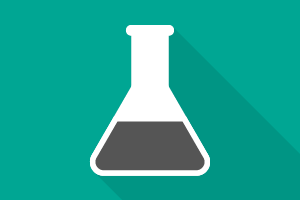Classroom Resources: Chemistry Basics
Filter by:
76 – 100 of 671 Classroom Resources
-

Titrations, Limiting Reactant, Acid Base Reactions, Indicators, Chemical Change, Equivalence Point, Stoichiometry, Balancing Equations, Chemical Change, Graphing, Error Analysis, Chemical Change, Error Analysis, Measurements, Concentration, Molarity | High School
Lab: Acid-Base Mole Ratio Mark as Favorite (16 Favorites)
In this lab, students study several concepts, including acid-base reactions, limiting reactants, and stoichiometry, by observing the contained reaction of acetic acid (diluted vinegar) with sodium hydrogen carbonate (baking soda) in an unconventional, cost effective titration.
-

Atomic Radius, Electron Affinity, Ionization Energy, Periodic Table | High School
Activity: Periodic Trends Investigation Mark as Favorite (108 Favorites)
In this activity, students investigate trends in atomic radius, electron affinity, and ionization energy using an online interactive periodic table.
-

Classification of Reactions, Balancing Equations, Chemical Change, Conservation of Mass, Observations | High School
Lab: Classifying Reaction Types Mark as Favorite (112 Favorites)
In this lab, students will carry out seven reactions and classify their reaction types. They will make observations, predict products, and balance the equations that represent the chemical reactions that are occurring.
-

Electrostatic Forces, Subatomic Particles, Electrons, Electricity, Electrons, Graphing | High School
Lab: Electromagnetic Forces in the Atom Mark as Favorite (6 Favorites)
In this lab, students will better understand that opposite charges attract each other, and like charges repel.
-

Intermolecular Forces, Intermolecular Forces, Polarity, Molecular Motion, Molecular Motion, Physical Properties | High School
Activity: Simulation Activity: Comparing Attractive Forces Mark as Favorite (125 Favorites)
In this activity, students will use a simulation to investigate different types of intermolecular forces (London dispersion, induced dipole, and hydrogen bonding). In the analysis that follows the activity, they will relate IMFs (also including dipole-dipole) to physical properties (boiling point, solubility, and vapor pressure). This activity and simulation are appropriate for students in any level chemistry course.
-

Ionic Bonding, Naming Compounds, Molecular Formula, Ions, Ionic Radius, Solubility, Melting Point, Physical Properties | High School
Activity: Ionic Bonding Brackets Mark as Favorite (74 Favorites)
In this lesson, students will demonstrate their knowledge of ionic bond strength and its relationship to the properties of melting point and solubility using a “brackets” activity. After analyzing the ionic charge and radius to predict the strongest and weakest bond between four pairs of ionic substances, they will then determine which will be the least soluble.
-

Mixtures, History, Physical Properties, Periodic Table, Atomic Structure, Ions | High School
Lesson Plan: George Eastman, Kodak, and The Birth of Consumer Photography Mark as Favorite (8 Favorites)
In this lesson, students will learn about George Eastman’s contributions to modern day photography, as well as the history and chemistry of photosensitive chemicals through reading an article and engaging in related activities. The activities help promote literacy in the science classroom. This lesson could be easily used as plans for a substitute teacher, as most of the activities are self-guided.
-

Observations, Interdisciplinary | Middle School
Lab: Jello Lenses Mark as Favorite (3 Favorites)
In this lab activity students will explore and compare how different lenses made from Jello can magnify text. Student lab groups will make Jello lenses using different sized measuring spoons, small bowls, and cookie dough scoops. They will then observe if the size of the lens changes magnification.
-

Chemical Change, Observations, Redox Reaction, Electron Transfer, Oxidation Number, Chemical Change, Activation Energy | High School
Lesson Plan: Cyanotypes: Taking Pictures with the Sun Mark as Favorite (16 Favorites)
In this lesson, students will read about the chemistry behind two photographic methods, including cyanotypes, and then prepare their own sun-sensitive cyanotype paper from two different types of paper. They will place items of their choosing on the prepared papers, place them in the sunlight, and develop and compare the images. Finally, students will be asked to think about different variables they could test with adjustments to the original procedures.
-

Identifying an Unknown, Solutions, Solubility, States of Matter, Melting Point, Phase Changes, Acids & Bases, pH, Strong vs Weak, Observations, Molecular Motion | High School
Activity: Simulation Activity: Identifying Unknowns with Safety Data Sheets Mark as Favorite (19 Favorites)
In this activity, students will use a simulation to learn about some of the sections of a safety data sheet (SDS) and how the information on SDSs can be used not only for safety purposes but also for identifying unknowns. Specifically, students will use “Section 9: Physical and Chemical Properties” to distinguish between two or three substances with similar appearances in a variety of lab-based scenarios. Particle diagrams are also included to help students visualize the substances’ behavior on a particulate level.
-

Identifying an Unknown, Solutions, Solubility, States of Matter, Melting Point, Phase Changes | High School
Simulation: Safety Data Sheets Mark as Favorite (13 Favorites)
Students learn about sections of a safety data sheet (SDS) and how the information can be used for safety purposes and for identifying unknowns. They will use the Physical and Chemical Properties section and particle diagrams to distinguish between substances with similar appearances in a variety of lab-based scenarios.
-

Lab Safety, Introduction, Review | Middle School, High School
Activity: Laboratory Equipment Scramble Mark as Favorite (10 Favorites)
In this activity, students will be challenged to solve a set of scrambled word puzzles. Each scrambled word corresponds to the name of a common piece of chemistry laboratory equipment. After solving each puzzle, students will use designated letters from each word to solve a riddle.
-

Observations | Middle School, Elementary School, High School
Activity: Compare and Contrast Mark as Favorite (4 Favorites)
In this activity, students will use their observation skills to compare and contrast two similar chemistry classroom scenes in order to identify the differences between the two.
-

Chemical Change, History, Identifying an Unknown, Molecular Structure | High School
Lesson Plan: Development of Diagnostic Test Strips Mark as Favorite (6 Favorites)
In this lesson, students will learn about diagnostic test strips by reading an article and engaging in related activities. The activities help promote literacy in the science classroom. Parts of this lesson could be used as plans for a substitute teacher.
-

Saturated vs. Unsaturated, Molecular Structure , Molecular Structure, Covalent Bonding, Lewis Structures, Interdisciplinary, Dimensional Analysis, Intermolecular Forces, Melting Point | High School
Lesson Plan: Dietary Fats Mark as Favorite (12 Favorites)
In this lesson, students will learn about the chemistry of dietary fats in the food they eat. They will calculate the number of calories coming from fats, carbohydrates, and proteins based on a food label before completing a guided activity focused on investigating the chemical structures of different types of fats. Students will then engage in a literacy component where they will use an article about the biological role of various types of dietary fats and foods to answer a series of questions.
-

Electromagnetic Spectrum, Observations, Scientific Method, Experimental Design, Error Analysis, Accuracy, Chemical Properties | High School
Lesson Plan: Screen Your Sunscreen! Mark as Favorite (8 Favorites)
In this lesson, students will learn more about UV radiation, its effect on skin, and the different ways in which sunscreen protects skin. After exploring this, students will develop an investigation to assess the claims made by different sun protection products. Students will compare the effectiveness of a variety of sunscreens and/or clothing that claim to offer sun protection. The lab will be wrapped up with a CER-style report.
-

Observations, Physical Properties, Interdisciplinary | Middle School
Lesson Plan: Fashionable Chemistry Mark as Favorite (1 Favorite)
In this lesson, students will explore the characteristics of different types of natural and synthetic fabrics. Students will learn how synthetic fabrics are made and review the chemical formulas for various fabrics. Finally, students will demonstrate their knowledge by holding a chemistry fashion show.
-

Reaction Rate, Catalysts, Experimental Design, Chemical Change, Reaction Rate, Chemical Change | Middle School
Lesson Plan: Investigating Fast and Slow Reaction Rates Mark as Favorite (0 Favorites)
In this lesson, students will review the characteristics of chemical changes and then use a catalyst and an inhibitor to explore the reaction rate of the oxidation of iron.
-

Radiation, Electromagnetic Spectrum, Heat, Temperature, Experimental Design, Graphing, Interdisciplinary | Middle School, High School
Lesson Plan: The Ozone Layer Mark as Favorite (8 Favorites)
In this lesson, students will develop an explanation for the consequences of ozone depletion on Earth by planning and carrying out an investigation. Students will use analysis and interpretation of data to develop a model to explain the cause and effect of Ozone depletion on the planet Earth.
-

Atomic Theory, Model of the Atom, Atoms, Subatomic Particles, Electrons, Orbitals , History, Matter | High School
Lesson Plan: Modeling Atomic Theories with Food Mark as Favorite (41 Favorites)
In this lesson, students will create an initial model of an atom (using various food items) drawing from the knowledge that they brought into the class. They will then use the same materials to work through an interactive note-taking lesson on how the model of the atom evolved over time. Having completed the interactive notes, the students return to their original models and adjust as needed.
-

Physical Properties, Chemical Properties, Elements, Alloys, Chemical Bond | Middle School
Lesson Plan: Behind the Metal Mark as Favorite (4 Favorites)
In this lesson, students will learn about the properties of metals. The students will work in small groups to create a video to anthropomorphize their selected metal as though it were a heavy metal musician and share the video with their peers.
-

Freezing Point, Density, Phase Changes, Melting Point, Molecular Motion, Physical Change, Physical Properties | Elementary School
Lesson Plan: Pothole Science Mark as Favorite (3 Favorites)
In this lesson, students investigate how the density and therefore the volume, of water changes when it freezes.
-

Photosynthesis, Interdisciplinary | Elementary School, Middle School
Lesson Plan: Investigating Photosynthesis Mark as Favorite (0 Favorites)
In this lesson, students will build knowledge through reading an assigned passage, as well as analyze evidence produced from a teacher led demonstration to better understand the process of photosynthesis.
-

Concentration, Graphing, Electromagnetic Spectrum | High School
Lesson Plan: Determining the Time of Death Mark as Favorite (43 Favorites)
In this lesson, students will perform a flame test on a sample of vitreous humor (liquid found in the eyeball) in a forensic investigation. They will determine which element from the sample is used to determine the time of death. Then they will engineer a simple spectrophotometer to quantify that element. Evaluating a fake sample of vitreous humor in their spectrophotometer will help them determine the time of death for a hypothetical cadaver.
-

Introduction, Lab Safety, Chemical Properties, Physical Properties, Chemical Change, Physical Change, History, Separating Mixtures, Elements, Mixtures, Density, Measurements, SI Units, Significant Figures, Dimensional Analysis, Scientific Notation, Accuracy, Molecular Motion, Phase Changes | High School
Lesson Plan: The Chemistry Basics and Measurement Quick Start Unit Plan Mark as Favorite (82 Favorites)
This Quick Start Unit Plan includes all the materials that a teacher will need for the first 10 class meetings of the school year. Each day is outlined with teacher notes, and includes slide presentations as well as directions for demonstrations, activities and labs to use. The fundamental topics covered in the 10 days of lessons are: laboratory safety, laboratory equipment, experimental design, classification of matter, chemical properties, physical properties, chemical change, physical change, phase changes, separation techniques, dimensional analysis, unit conversions, factor label method, accuracy, precision, significant figures, and percent error calculations. This Quick Start Unit plan aims to help students to build a foundation of understanding, and master important topics before moving deeper into the chemistry curriculum.